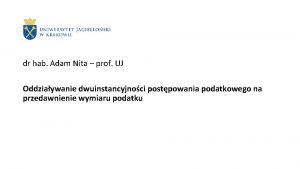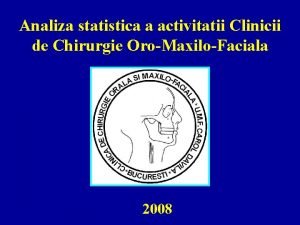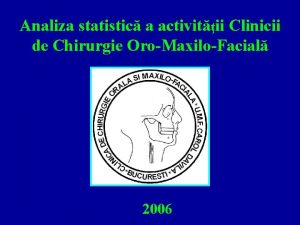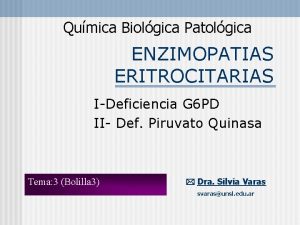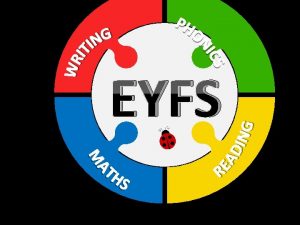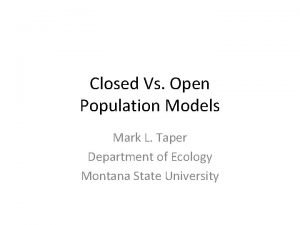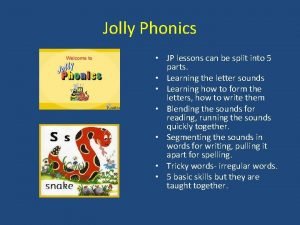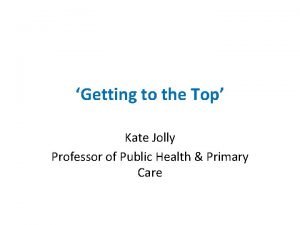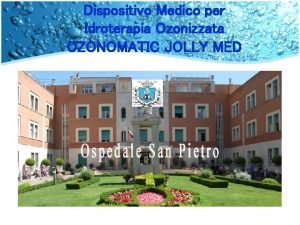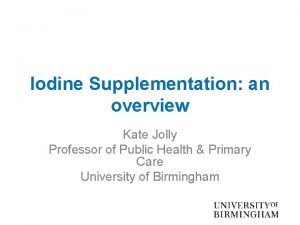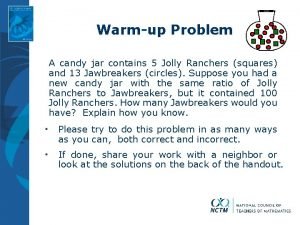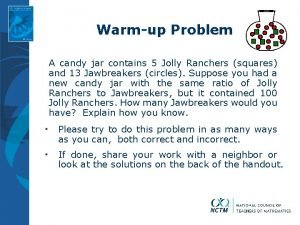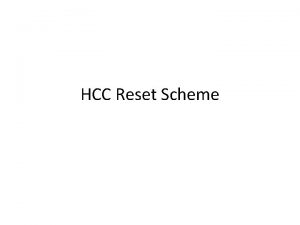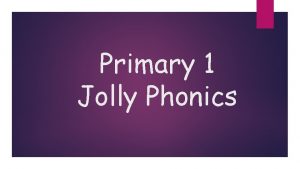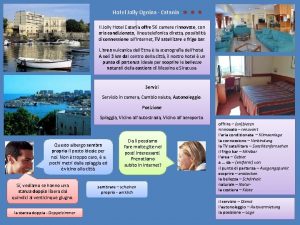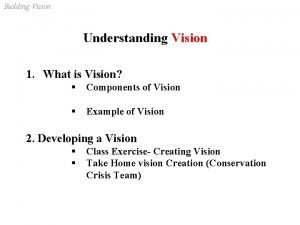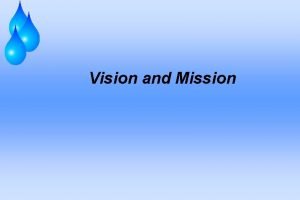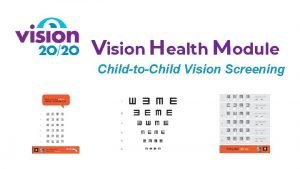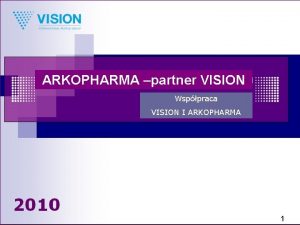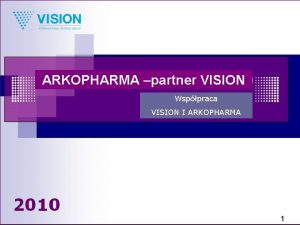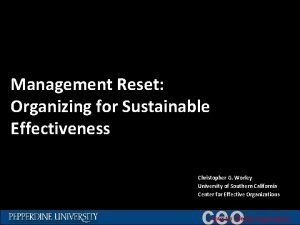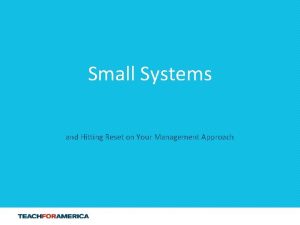Vision for a Program Management Reset Nita Jolly






















- Slides: 22

Vision for a Program Management Reset Nita Jolly Acting Deputy Director General, Settlement Network Fall 2018

Purpose To provide an overview of: • The operating context of our current program and the drivers of change. • The work that has been done to date to streamline processes, and highlight work that is being considered. • The long term vision for how we manage and administer our program. • Key success dependencies. 2

Vision To encourage and support the evolution of our program by recalibrating our administrative processes, our tools, and our overall approach, based on a more comprehensive risk assessment allowing funding recipients to move within a funding mechanism spectrum based on their risk assessment results. Desired Impacts • Funding recipients can maximize time spent delivering services to newcomers and further develop their capacity and expertise. • Create time and space for Officers to focus on value-added activities, such as: • increased engagement with service provider organizations; • information gathering on local needs and how they relate to national priorities and trends; and • ongoing analysis of gaps in services. 3

Considerations: Drivers of Change • There is a wider Government of Canada direction towards streamlining financial management for grants and contribution programs. • Our consultations show that our funding recipients see opportunities for improvement, as does IRCC. • Since its inception in 2016, SN has undertaken broad reviews and consultations, both formal and informal, on current practices and procedures. • • • Call for Proposals (CFP) 2015 Post mortem Expression of Interest (EOI) for Service Delivery Improvements (SDI) Office of the Auditor General (OAG) Report CFP 2019 planning Business Modelling Exercise This work is part of a broader vision that includes all aspects of our business, from the priority-setting stage and the intake processes, to the negotiation and management of the CA. 4

Consultations and Suggestions Informing our Review • Service Provider perspective • • • Charting a New Direction Discussion Paper – 15 recommendations Settlement Program Evaluation CFP 2015 Post Mortem Lessons learned assessment on EOI for SDI (currently in progress) Topics of concern e. g. property tax rebates; section 91 of IRPA • IRCC perspective • • • Focus group on administrative burdens to Officers and SPOs CFP 2015 Post Mortem Lessons learned assessment on EOI for SDI (currently in progress) Settlement Design Challenge Settlement Training Design workshop Consultation with Other Government Departments Best practices across the network Alignment with upcoming changes from TBS OAG Report Business modelling exercise 5

Drivers & Enablers Contributing to the Program Management Reset Vision 6

An Integrated Approach to a Program Management Reset • Consolidating what we have heard from both IRCC staff and external stakeholders, and using this to direct our way forward. • Complementing external feedback with an internal assessment of how things could be recalibrated to work more effectively, given our priorities as a Department, as a Sector and as a Branch. • Continuous improvement via ongoing experimentation and pilots, supported by feedback (internal & external) as we develop and test new ways of managing our program. • A key element of this is re-thinking the nature of the Officer-SPO relationship. Transformational change requires a culture change in the design, delivery and management of how we develop and implement our CA management processes at various levels. This includes changes at the sectoral level as well. 7

8

Impact of a Program Management Reset on Our Relationships and Roles From… Officer /IRCC SPO/ Funding Recipient To… • Reactive approach to engagement with stakeholders • Enforcement-based oversight and information gathering • Need-to-know basis approach to internal requests • Proactive approach to engagement with partners • Information-gathering to increase collaboration • Developing an expertise of newcomer needs within the context of the community being served. • Apprehensive to inquiries made by Officers • Large focus on transactional elements • Emphasis on reporting up rather than achieving results • Interest in sharing successes as well as challenges • Working in an environment of mutual trust • Increased attention to delivering outcomes and client needs 9

Intake Modernization A more frequent, but simpler and customized engagement with the sector. • We launched our first Expression of Interest Process in November 2017. • We will continue to refine this process with a view to improving the user experience and holding at least two processes per year. • Establishment of clear solicitation process options supported by clear service standards: 1. Prescribed solicitation – Specific need in a prescribed way (more targeted) 2. Call for Concepts / ideas – Open solicitation to obtain new ideas (broader) 3. Call for Proposals – Defines the services required but not the way in which the service should be delivered 4. Unsolicited proposals – a formal protocol to receive and manage these proposals without unreasonable burden • Implementation date: Summer 2018 10

An Improved Planning Process Budgets will be communicated in mid-November with a 3 year budget range to improve budget predictability for our service providers • We will communicate 2019/20 fiscal budgets by November 15 th rather than early in the calendar year. • We will provide a 3 year budget planning horizon: years 2 and 3 will provide a range to allow adjustments related to actual landing data. • This new planning cycle will allow us to initiate negotiations earlier in the year, on a multi-year basis, resulting in a reduced number of amendments over the cycle of a contribution agreement. • Some contribution agreements resulting from CFP 2019 will be negotiated for up to 5 years rather than 3 years. 11

Critical Success Dependency: A balanced approach to risk to allow reporting and budget flexibilities • We will adopt an approach where our management of risk is wellinformed and supports programming that is responsive, innovative, and increasingly outcomes-based. • Current reporting requirements are driven by an assessment of risk that is somewhat rigid and primarily based on the value of the agreement rather than a wider spectrum of considerations such as: • • Financial viability of the organization over time Capacity of the SPO to deliver our programs Our lived experience in dealing with the organization Community/context in which the organization delivers services • This new approach will result in more meaningful reporting and oversight requirements as well as more budget flexibility when appropriate. 12

Meaningful Reporting and Oversight A more responsive, outcomes-focused and responsible approach that is tailored to risk and stewardship • Recalibration of our risk assessment will allow us to reduce reporting and oversight requirements for some of our recipients, depending on their risk assessment results. • Once implemented, reporting requirements could vary between quarterly to annually, depending on risk rating and score of the proposal and organization. Reporting and Oversight Spectrum Rating • Need for oversight is considered to be greater • Less administrative oversight needed • Reporting requirements are higher • Fewer reports are required 13

Budget Flexibility Budget flexibility dependent on organizational risk assessment. • Immediate changes (April to September 2018): • Reduction in the level of detail required in Schedule 2 SDI Agreements • Reinvestment of property tax rebate now allowed • Increased flexibility in overhead (admin) rates for organizations with smaller budgets. • Increased threshold for major amendments from 20% to 25% • In future, recipients may have increased access to unused funds from previous FY depending on where they fall along the integrated risk spectrum. Budget Flexibility Spectrum Rating • • Unable to access carry over funds. Less flexibility for making budget reinvestments • • Ability to access some unused funds. Increased flexibility for budget reinvestments • • Ability to access up to a percentage of funds Increased flexibility in making budget reinvestments (subject to TBS approval) 14

Program Management Reset– An Integrated Risk Spectrum Current Process Drivers Proposal Assessment (Rating %) FRAM Reporting Requirements Level of Risk (Rating %) Future Process Drivers Reporting Proposal Assessment (Rating %) Organization (Rating %) Requirements Overall Rating % Will Dictate Funding Mechanism Project Stream (Rating %) Funding Mechanism Spectrum New Funding Mechanisms (Grants) Traditional Funding mechanism (CA’s) • • • Need for oversight is considered to be greater Reporting requirements are higher Less budget flexibility • • • Less administrative oversight needed Fewer reports are required More budget flexibility 15

Between Now and Future State… • Accept scanned signatures to reduce exchange of documents – Summer 2018 • Further reduction of line items for all CAs, which will simplify the details required in cash flows. Fall 2018 • Increased flexibility in overhead (admin) rates for organizations with smaller budgets – Fall 2018 • Threshold for major amendments will be increased to 25% in phase 1 (Summer 2018), with further adjustments to be considered as part of phase 2 (Spring 2019). • Simplify and reduce the frequency of narrative reporting – Fall 2018 • Introduce grant authority for certain projects that are assessed as meeting the corresponding risk criteria, reducing reporting requirements and eliminating the need for cash flow projections – Spring 2019. 16

Implementation Principles • Make improvements to the program management processes and tools as opportunities arise. • Leverage all opportunities to engage with the sector, particularly while planning and developing our approach moving forward. Working groups will be established to engage the sector in defining the risk criteria supporting this framework. • Develop a comprehensive change management strategy to ensure Officers are well-supported, and appropriately equipped to facilitate changes at the local level. • Improve the user experience to allow funding recipients to focus more on achieving results for our newcomer clients. • A key milestone for more significant changes will be the implementation of CFP 2019. 17

The Way Forward - Vision Implementation • We will continue to explore further changes to how we administer and manage our program, based on a renewed assessment of risk that aligns with our overall vision for the program management reset. • To support more time spent on value-added activities for both IRCC staff and funding recipients, we are investigating underlying reasons for more common irritants (i. e. : cash flows) to see where changes are warranted. • We will engage funding recipients throughout the process in order to assess and understand the impact of our decisions/changes. • The sector will be a key partner in the implementation of this longer term vision and to ensuring that the growth and renewal of our program is responsive and relevant to the needs of our clients and their communities. 18

Renewed Engagement • We want to encourage a re-imagination of how we engage with our partners, with our work, and with our clients. • We are looking to engage internally and externally and at various levels in order to have a holistic understanding of why we do things the way we do, in order to support change from the ground up. • We recognize that change needs to be rooted in corporate culture and informed by shared values. • We are relying on traditional partners, new partners, as well as our own staff to help us define what ‘success’ looks like in order to manage change in a way that is meaningful and produces common indicators of success. • We believe that capacity and leadership exists at all levels, and as such, will seek out opportunities to bring alternative perspectives to the surface. 19

The Settlement sector has a key role to play in the successful implementation of the vision for the Program Management Reset. Ongoing engagement, a strong feedback loop, and an openness to learning throughout this process will be key to ensuring our success. 20

ANNEX 1: Recommendations From Focus Groups 21

Recommendations From Focus Groups (Cont’d) 22
 Fim password reset registration
Fim password reset registration Nita 3000 2020
Nita 3000 2020 Adam nita uj
Adam nita uj Horatiu bodnar
Horatiu bodnar Tiberiu nita
Tiberiu nita Sandeep singh jolly berlin
Sandeep singh jolly berlin Once a jolly swagman
Once a jolly swagman Actividad enzimatica
Actividad enzimatica Jolly phonics p
Jolly phonics p N jolly phonics
N jolly phonics Jolly phonics f
Jolly phonics f Jolly dipper menu
Jolly dipper menu Hemácias em alvo
Hemácias em alvo Zieve syndroom
Zieve syndroom Jolly phonics
Jolly phonics Kate jolly
Kate jolly Jolly med
Jolly med Jolly tota
Jolly tota Kate jolly
Kate jolly Simon jolly
Simon jolly Jar of problems
Jar of problems Simon jolly
Simon jolly Simon jolly
Simon jolly


